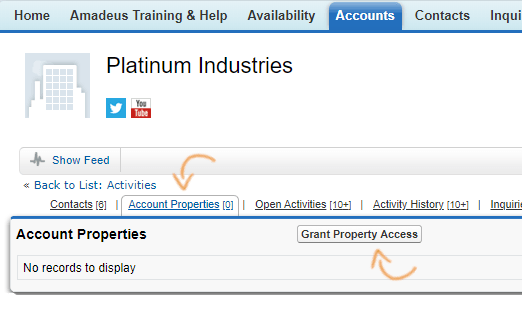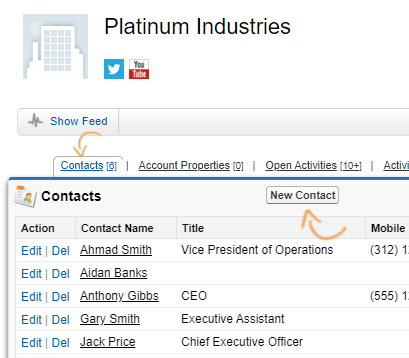Topics: Sharing accounts | Agencies | Contacts
Accounts and contacts
The content of this page is specific to the Delphi product type only. If you are using the Delphi Core product type and want to learn more about the Delphi product type, contact your sales representative.
Creating and managing accounts and contacts is very straightforward. Before creating a new account, you'll want to search for it—just to make sure the account hasn't already been added to the system. If you do not find it, click the Accounts tab and then click the New button.
Complete the fields on the New Account page and then click Save. After you save you can add contacts, tasks, inquiries, and bookings directly from the Account page.
As you work through the system, communicate with your property administrator about fields that do not apply to your property, or information that you might like to add. Property administrators can then discuss with the corporate administrator, who receives special training to learn how to customize the pages and fields. Because each corporate administrator can make these changes, your pages might look a little different than the examples displayed here in the training.
Sharing accounts
When your Salesforce org was created, your company determined how they wanted the security of accounts and contacts to work. Security can be customized many different ways, but most of our customers use one of these two approaches:
Scenario 1: Accounts and contacts are shared automatically with all properties. This means everyone with a login works on the same list of accounts and contacts. Aside from users with read-only access, you can create, modify, and add activities to all of the records and so can everyone else.
Typically the sharing stops there. When you create an inquiry, booking, or volume contract only those with access to your property can see them. But this is also a security decision that is made by your corporate administrator, so check with your colleagues to make sure you know what to expect.
Scenario 2: Accounts are property-specific unless steps are taken to share them with other properties. When you create an account, the default property you selected in Amadeus User Settings is automatically assigned access. If you want to share it with other properties, you have to take an extra step after you save.

At the top of the Account page—use the section quick links. Point to Account Properties and click the Grant Property Access button. Then select the properties you want to share the account with and save.
Agencies
In addition to accounts, you can also manage travel agencies. After an agency has been created, you can add agents and link the agency to a booking. This allows you to report on revenue generated by third parties, and calculate commission payments.
The steps for creating an agency and an account are almost exactly the same. The only difference is that in the Type field you'll select Agency instead of Account. Like accounts, you'll want to search for the agency before creating a new one.
Contacts
There are several ways to add contacts. Your instinct might be to open the Contacts tab and then click the New button; however, there is a better way.
From the Account page—use the section quick links at the top of the page. Point to Contacts and click the New button. Enter the contact details and click Save.

When you create a contact from the Account page, the contact is automatically linked, and the account address and phone number copy into the contact, saving you time. After you create the contact, you can add tasks, inquiries, and bookings directly from the Contact page so they will instantly be linked to the contact and account.
The first contact you add to an account is automatically assigned as the primary contact. The primary contact is used in account merge documents and will be the default contact for any bookings created from the account—of course you can change the contact on your booking as needed.
A contact follows the same sharing rules as its associated account. If the account is shared, then so is the contact. If a contact is created and is not associated to an account, the contact is private and can only be viewed and modified by its owner.
Quiz time
- You created a new account for the local hospital. Can people at other properties see it and add their own contacts to it?
- Yes. Everyone at every property can see and edit all accounts.
- No. Only those who have access to my property can see my accounts unless I share it.
- It depends. The security of accounts is determined by the corporate administrator.
Summary
Before you create an account, always remember to search to make sure it does not exist. Duplicate accounts create problems for reporting and can be a real hassle to clean up. Clicking the Accounts tab or the Contacts tab displays a list of the recent ones you worked with so you don't even need to search most of the time. Creating bookings from the Contact page saves time because it automatically links both the contact and account.
Before you book business, you need to make sure you have the right kind of space available. Select the next lesson based on whether or not your property sells guestrooms.
Next Topic > Availability: Guestrooms and Function Space OR > Availability: Function Space Only